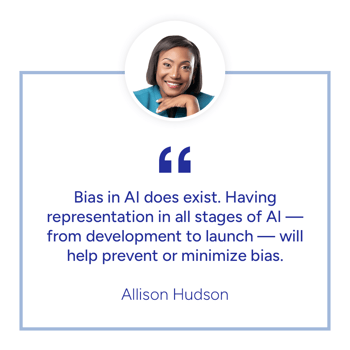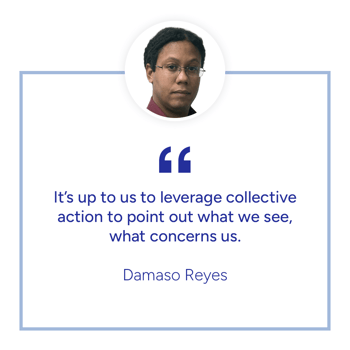In our webinar hosted with Black PR Wire, AI in the Black Community, a panel of experts discussed the role of artificial intelligence within several industries. Among the topics that sparked considerable interest were the implications of AI on misinformation and disinformation in journalism and how to combat racial bias.
Based on the discussion, read on to see what Terysa Ridgeway (Google), Damaso Reyes (New York Amsterdam News), Allison Hudson (AHH Consulting LLC), Farah Allen (The Labz), Ayana Elon (Black Girl Ai), and Bernadette Morris (Black PR Wire, Sonshine Communications) had to say.
What is Misinformation?
| Misinformation refers to false or inaccurate information that is spread (often rapidly) through various channels such as social media, news outlets, or word of mouth. Whether a rumor, conspiracy theory, or hoax, misinformation takes many forms and can be harmful, leading to misunderstanding, confusion, and distrust. |
4 out of 10 Americans who get news from social media say inaccuracy is what they dislike most about it. |
What is Disinformation?
Disinformation is the intentional spread of misleading information to deceive, manipulate, or influence public opinion or behavior. Unlike misinformation, which may spread inadvertently, disinformation is strategically crafted and shared to achieve specific goals, such as shaping narratives, discrediting someone or an organization, or promoting certain ideologies. The spread of disinformation can undermine trust in institutions, create societal division, and have far-reaching consequences on public discourse and decision-making processes.
|
55% of Americans support the U.S. government taking steps to restrict false information online. |
While both misinformation and disinformation involve the spread of false information, the crucial distinction lies in intent. Misinformation is typically unintentional, stemming from errors or lack of verification, while disinformation is a deliberate and calculated effort to deceive or manipulate. |
The Rise of Misinformation and Disinformation in Journalism
Misinformation and disinformation are not new—think tabloids or propaganda. But with the advent of the internet and social media, misinformation and disinformation have become more prevalent and accessible than ever before. Anyone with an internet connection can publish content, leading to the rapid spread of false information and conspiracy theories. Social media platforms are also used to manipulate public opinion and sow division through targeted disinformation campaigns.
|
Digital devices are the most common way Americans access the news. |
The digital nature and fast pace of our world today have accelerated the spread of misinformation and disinformation, making them difficult to combat. And now, with the rapid growth of artificial intelligence, things have become more complicated. |
AI’s Influence on Spreading Misinformation and Disinformation
The rise of artificial intelligence (AI) has had a significant impact on the spread of misinformation and disinformation in journalism, both amplifying the problem and providing tools to combat it.
- Automated Content Generation: AI technologies, such as natural language generation (NLG) algorithms, can quickly generate news articles, blog posts, and social media content. While this can streamline content creation, it also opens the door for malicious algorithms to produce false information.
- Deepfake Technology: Deepfake technology uses AI to create hyper-realistic fake videos or audio recordings that can depict individuals saying or doing things they never did. This has the potential to spread untrue information by making it appear as though real events occurred, leading to confusion and manipulation of public perception.
- Algorithmic Bias: AI-powered algorithms used by social media platforms and search engines can inadvertently promote misinformation by prioritizing sensational or polarizing content for the sake of higher engagement. This can create echo chambers where users are exposed to content that reinforces their existing beliefs (including about race), regardless of its accuracy.
- Automated Fact-Checking: On the flip side, AI-driven fact-checking tools have been developed to combat misinformation by automatically analyzing large volumes of content for accuracy. These tools use natural language processing algorithms to identify misleading or false information and provide real-time corrections or context to users.
- Detection of Disinformation Campaigns: AI algorithms can analyze patterns in online behavior, such as the spread of specific hashtags or the use of bot accounts, to detect and flag potential disinformation campaigns. This enables platforms and authorities to take action to mitigate the impact of such campaigns.
- Content Moderation: AI-powered content moderation tools are used by social media platforms to identify and remove harmful or misleading content, including misinformation and disinformation. However, these tools are not foolproof and can sometimes result in the inadvertent censorship of legitimate content.
- Enhanced News Gathering: AI technologies can assist journalists in gathering and analyzing vast amounts of data from various sources, helping them uncover trends, detect anomalies, and verify information more efficiently. This can improve the accuracy and reliability of news reporting, thereby reducing the spread of misinformation.
AI and Racial Bias
 Just as AI has the potential to perpetuate false information, it can also perpetuate racial bias and discrimination.
Just as AI has the potential to perpetuate false information, it can also perpetuate racial bias and discrimination.
- Lack of Diversity in AI Development: The lack of diversity among AI researchers and developers can contribute to the spread of racial bias. Without diverse perspectives and experiences, developers may overlook or underestimate the potential for bias in their algorithms, leading to unintended discriminatory outcomes.
- Biased Data: Lack of diversity in AI development leads to AI algorithms that aren’t trained on vast datasets and contain inherent biases. For example, facial recognition software has been shown to have higher error rates for people of color due to biases in the training data.
- Automated Decision-Making: AI systems are increasingly used for automated decision-making processes in various domains, including criminal justice, lending, and employment. If these systems are not rigorously tested for bias and fairness, they may perpetuate existing disparities by disproportionately penalizing or disadvantaging certain racial groups.
Addressing racial bias in AI requires a multifaceted approach that includes diversifying the tech industry, improving data collection and curation practices, implementing fairness-aware algorithms, and ensuring transparency and accountability in automated decision-making processes. By addressing these challenges, we can work towards creating more equitable and inclusive AI systems that mitigate, rather than perpetuate, racial bias.
We Embrace AI. But How Can We Make It Better?
 Combatting misinformation and disinformation requires a concerted effort from individuals, organizations, governments, and technology platforms. How can we tackle this?
Combatting misinformation and disinformation requires a concerted effort from individuals, organizations, governments, and technology platforms. How can we tackle this?
- Promote Media Literacy: Educate yourself, family, and friends about critical thinking skills, fact-checking techniques, and media literacy to help discern credible sources from misinformation.
- Fact-Checking: Support and promote independent fact-checking organizations that verify the accuracy of news stories and debunk false information. Fact-check information before sharing it.
- Transparency and Accountability: Hold media organizations, journalists, and social media platforms accountable for the accuracy and integrity of the information they share. Encourage transparency in reporting practices and algorithms.
- Diverse Media Consumption: Seek out information from diverse sources. Expose yourself to viewpoints from multiple perspectives.
- Combat Echo Chambers: Promote constructive dialogue and engagement with individuals who hold different viewpoints. Encourage respectful debate to challenge misinformation and disinformation.
- Regulatory Measures: Advocate for policies that hold social media platforms and tech companies accountable for the spread of misinformation and disinformation, address harmful content, and increase transparency.
- Support Independent Journalism: Support and invest in independent journalism and news organizations that uphold journalistic integrity and ethics.
 AI and Technology Solutions: For the tech-savvy, develop and deploy AI-powered tools and technologies to detect and mitigate the spread of misinformation and disinformation online. Implement algorithms that prioritize credible sources and flag suspicious content.
AI and Technology Solutions: For the tech-savvy, develop and deploy AI-powered tools and technologies to detect and mitigate the spread of misinformation and disinformation online. Implement algorithms that prioritize credible sources and flag suspicious content.- Community Engagement: Engage with local communities and grassroots organizations to address specific issues and concerns related to misinformation and disinformation. Foster collaboration and cooperation to combat false narratives and promote accurate information.
- Crisis Communication Strategies: Develop crisis communication strategies to respond effectively to instances of misinformation and disinformation.
From automated content generation to algorithmic bias and deepfake technology, AI presents both challenges and opportunities. The intersection of AI and racial bias underscores the importance of addressing diversity in AI development and ensuring fairness in automated decision-making processes. To confront these issues, a collaborative effort is needed. By promoting media literacy, supporting fact-checking initiatives, advocating for transparency and accountability, and embracing diverse perspectives, we can deter fake news and combat racial bias while continuing to embrace AI advancements.
Learn More
Get the latest PR, IR, Marketing, and Media tips on the Business Wire Blog. Subscribe today!






